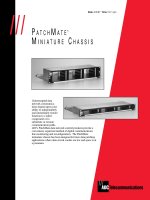Tài liệu Hibernate Tutorial 12 pptx
Bạn đang xem bản rút gọn của tài liệu. Xem và tải ngay bản đầy đủ của tài liệu tại đây (28.16 KB, 8 trang )
Page 1 of 8
Hibernate Tutorial 12 Caching Objects
By Gary Mak
September 2006
1. Level of caching
The general concept of caching persistent objects is that when an object is first read from external
storage, a copy of it will be stored in the cache. For the subsequent readings of the same object, it
can be retrieved from the cache directly. Since caches are typically stored in memory or local disk,
it will be faster to read an object from cache than external storage. If using properly, caching can
greatly improve the performance of our application.
As a high performance O/R mapping framework, Hibernate supports the caching of persistent
objects at different levels. Suppose we get an object with same identifier for two times within a
session, will Hibernate query the database for two times?
Session session = factory.openSession();
try {
Book book1 = (Book) session.get(Book.class, id);
Book book2 = (Book) session.get(Book.class, id);
} finally {
session.close();
}
If we inspect the SQL statements executed by Hibernate, we will find that only one database query
is made. That means Hibernate is caching our objects in the same session. This kind of caching is
called “first level caching”, whose caching scope is a session.
But how about getting an object with same identifier for two times in two different sessions?
Session session1 = factory.openSession();
try {
Book book1 = (Book) session1.get(Book.class, id);
} finally {
session1.close();
}
Session session2 = factory.openSession();
try {
Book book2 = (Book) session2.get(Book.class, id);
} finally {
session2.close();
}
Page 2 of 8
We will find that two database queries are made. That means Hibernate is not caching the persistent
objects across different sessions by default. We need to turn on this “second level caching” whose
caching scope is a session factory.
2. The second level caching
To turn on the second level caching, the first step is to choose a cache provider in the Hibernate
configuration file “hibernate.cfg.xml”. Hibernate supports several kinds of cache implementation,
such as EHCache, OSCache, SwarmCache and JBossCache. In a non-distributed environment, we
may simply choose EHCache, which is also the default cache provider for Hibernate.
<hibernate-configuration>
<session-factory>
...
<property name="cache.provider_class">
org.hibernate.cache.EhCacheProvider
</property>
...
</session-factory>
</hibernate-configuration>
We can configure EHCache through a configuration file “ehcache.xml” located in the source root
folder. We can specify different settings for different “cache regions”, which are used for storing
different kinds of objects. The parameter “eternal” indicates that the elements will be expired in a
time period if set to false. The parameters “timeToIdleSeconds” and “timeToLiveSeconds” indicate
how long the elements will be expired.
<ehcache>
<diskStore path="java.io.tmpdir" />
<defaultCache
maxElementsInMemory="10000"
eternal="false"
timeToIdleSeconds="120"
timeToLiveSeconds="120"
overflowToDisk="true"
/>
<cache name="com.metaarchit.bookshop.Book"
maxElementsInMemory="10000"
eternal="false"
timeToIdleSeconds="300"
timeToLiveSeconds="600"
overflowToDisk="true"
/>
</ehcache>
Page 3 of 8
To monitor the caching activities of Hibernate at runtime, we can add the following line to the log4j
configuration file “log4j.properties”.
log4j.logger.org.hibernate.cache=debug
Now, we need to enable caching for a particular persistent class. The cached objects will be stored
at a region having the same name as the persistent class, e.g. “com.metaarchit.bookshop.Book”.
There are several cache usages we can choose for a persistent class. If the persistent objects are read
only and never modified, the most efficient usage is “read-only”.
<hibernate-mapping package="com.metaarchit.bookshop">
<class name="Book" table="BOOK">
<cache usage="read-only" />
...
</class>
</hibernate-mapping>
After the caching of Book class being enabled, we can see that only one SQL query is made even
the book object is loaded for two times in two different sessions.
Session session1 = factory.openSession();
try {
Book book1 = (Book) session1.get(Book.class, id);
} finally {
session1.close();
}
Session session2 = factory.openSession();
try {
Book book2 = (Book) session2.get(Book.class, id);
} finally {
session2.close();
}
However, if we modify the book object in one session and flush the changes, an exception will be
thrown for updating a read-only object.
Session session1 = factory.openSession();
try {
Book book1 = (Book) session1.get(Book.class, id);
book1.setName("New Book");
session1.save(book1);
session1.flush();
} finally {
session1.close();
}
Page 4 of 8
So for an updatable object, we should choose another cache usage “read-write”. Hibernate will
invalidate the object from cache before it is updated.
<hibernate-mapping package="com.metaarchit.bookshop">
<class name="Book" table="BOOK">
<cache usage="read-write" />
...
</class>
</hibernate-mapping>
In some cases, e.g. the database updated by other applications, you may want to invalidate the
cached objects manually. You can do it through the methods provided by the session factory. You
can invalidate either one instance or all instances of a persistent class.
factory.evict(Book.class);
factory.evict(Book.class, id);
factory.evictEntity("com.metaarchit.bookshop.Book");
factory.evictEntity("com.metaarchit.bookshop.Book", id);
3. Caching associations
For the associated publisher object of a book, will it be also cached when its parent book object is
cached?
<hibernate-mapping package="com.metaarchit.bookshop">
<class name="Book" table="BOOK">
<cache usage="read-write" />
...
<many-to-one name="publisher" class="Publisher" column="PUBLISHER_ID" />
</class>
</hibernate-mapping>
If you initialize the association in two different sessions, you will find that it is loaded for two times.
It is because Hibernate caches only the identifier of publisher in the region of Book.
Session session1 = factory.openSession();
try {
Book book1 = (Book) session1.get(Book.class, id);
Hibernate.initialize(book1.getPublisher());
} finally {
session1.close();
}
Page 5 of 8
Session session2 = factory.openSession();
try {
Book book2 = (Book) session2.get(Book.class, id);
Hibernate.initialize(book2.getPublisher());
} finally {
session2.close();
}
To cache the publisher objects in their own region, we need to enable the caching for the Publisher
class also. We can do it the same way as for Book class. The cached publisher objects will be stored
at a region with the name “com.metaarchit.bookshop.Publisher”.
<hibernate-mapping package="com.metaarchit.bookshop">
<class name="Publisher" table="PUBLISHER">
<cache usage="read-write" />
...
</class>
</hibernate-mapping>
4. Caching collections
For the associated chapters of a book to be cached, we enable caching for the Chapter class. The
cached chapter objects will be stored at a region with the name
“com.metaarchit.bookshop.Chapter”.
<hibernate-mapping package="com.metaarchit.bookshop">
<class name="Book" table="BOOK">
<cache usage="read-write" />
...
<set name="chapters" table="BOOK_CHAPTER">
<key column="BOOK_ID" />
<one-to-many class="Chapter" />
</set>
</class>
</hibernate-mapping>
<hibernate-mapping package="com.metaarchit.bookshop">
<class name="Chapter" table="CHAPTER">
<cache usage="read-write" />
...
<many-to-one name="book" class="Book" column="BOOK_ID" />
</class>
</hibernate-mapping>
Then we can try initializing the collection in two different sessions. We expect that no query should









